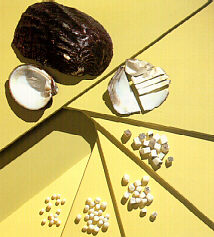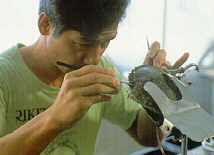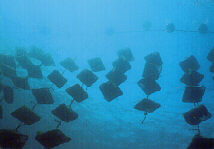Pearls educational
Cultivation & Process
Natural Pearls
The sea is the home of countless extraordinary creatures.
Of them all, one of the most simple and yet complex is the oyster, the mother of the pearl. From time to time, an alien body (a grain of sand, for example) may enter the oyster, which the animal then tries to expel. If it fails, the mollusk takes defensive action against the irritant and deposits around the intruder, in concentric layers, an iridescent substance known as nacre. In time, and with great luck, a natural pearl begins to form.
Cultured Pearls
In the process of cultivating pearls, men attempt to reduce elements of chance by skillfully inserting foreign matter into a healthy, mature oyster or mussel and then carefully nurturing the mollusk over periods of up to three years. It is far from the easy process it may, at first, appear to be.
For all its apparent simplicity, an oyster or mussel is an extremely delicate creature. However skilled the operation and cultivation procedures, a large percentage of these animals will eventually reject their implants. Of every 100 harvested pearls, only one or two will be perfect. A sizable percentage of every crop will be totally unusable and must be discarded. For these reasons, any pearl (cultured or natural) is considered one of Nature’s great miracles.
Today, there are three main groupings of cultured pearls: Akoya, South Sea, and Freshwater.
Cultivation
Generally speaking, all cultured pearls are cultivated in the same manner. Only certain elements of the process vary according to the type of oyster or mussel being used and, hence, the type of pearl obtained.
The cultivation process begins with the mother oyster being carefully brought up from its growing environment. The oyster is very gently opened, and kept open with the help of small wooden wedges. A sliver of tissue (called “mantle”) is taken from another living pearl oyster of the same species. Both the mother and donor oyster must be chosen with care, as it is only from perfect mollusks that pearls of the highest quality are likely to result.
This mantle tissue is finely sliced and a tiny section carefully inserted into a channel made in the soft tissue of the mother oyster by a surgical scalpel. In most cases, a nucleus is added at the same time. This is usually a small, spherical, mother-of-pearl bead made from the shell of freshwater mussels that come from either the United States or China.
Simple as this operation may sound, it is actually a very delicate procedure. The skill of the technician directly reflects upon the quality of the pearl eventually produced and the quantity of pearls harvested.
The oyster is then returned to its growth environment. Within two weeks, under optimum conditions, living graft tissue will have formed a pearl sac around the nucleus within which a perfect pearl will, hopefully, begin to grow.
From this point on, even greater care is taken with the oyster. Since it is vulnerable to parasites and other underwater growths, each shell is cleaned at regular intervals.
Because oysters are such extremely delicate creatures, the pearl farmer must take many other factors into account over the long cultivation period: the depth at which the oysters are suspended, water conditions such as temperature, salinity, currents and flow of plankton, plus predators, pollution and changing weather conditions, to name but a few.
The length of the cultivation period varies according to the type of mother oyster and the geographical location of the pearl farm. Generally speaking, however, it takes up to two or three years for an oyster to produce a pearl, although some species are harvested annually.




Processing
Processing cultured pearls begins immediately after harvesting. In most cases, pearls fresh from the sea are washed, sized and separated into broad categories. These raw materials are then sold or auctioned off in lots to pearl processors.
The processor must first determine the type of jewelry for which each cultured pearl would be most appropriate. Those to be mounted in brooches, rings, pendants and tie pins are drilled about halfway through. The majority are drilled completely through, for necklaces.
Next, most pearls (other than the South Sea variety) are submerged in a solution to help dissolve any organic impurities that may have caused natural stains, discolorations or blemishes.
The cultured pearls are now passed through a series of sieves to separate them by size. They are then further classified by quality.
The critical evaluation of each pearl’s shape, color and luster, as well the thickness of its nacreous coating and surface cleanliness, takes great expertise.
As an example, tints may range from light to dark, through every imaginable rainbow hue: pink, silver, champagne, cream, gold, green, blue or gray. Each major species of oyster tends to produce a generic color range, with dozens of permutations of its own.
The cultured pearls are now grouped according to size and other similarities. Matching pearls are strung into 14-inch or 16-inch strands. Loose pearls, to be used for other types of jewelry, are bagged into individual lots. From the processor, they move on to wholesalers before gracing the showcases of jewelers throughout the world.













